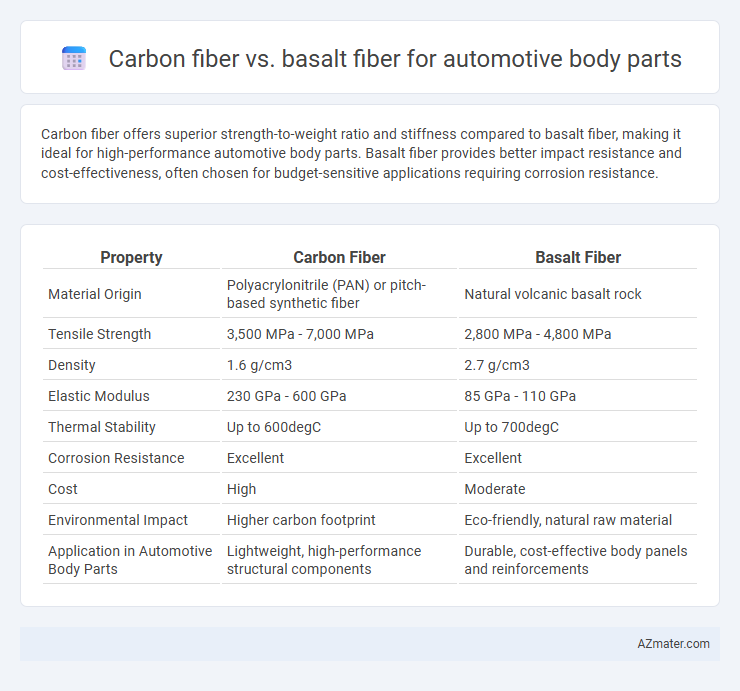Carbon fiber offers superior strength-to-weight ratio and stiffness compared to basalt fiber, making it ideal for high-performance automotive body parts. Basalt fiber provides better impact resistance and cost-effectiveness, often chosen for budget-sensitive applications requiring corrosion resistance.
Table of Comparison
| Property | Carbon Fiber | Basalt Fiber |
|---|---|---|
| Material Origin | Polyacrylonitrile (PAN) or pitch-based synthetic fiber | Natural volcanic basalt rock |
| Tensile Strength | 3,500 MPa - 7,000 MPa | 2,800 MPa - 4,800 MPa |
| Density | 1.6 g/cm3 | 2.7 g/cm3 |
| Elastic Modulus | 230 GPa - 600 GPa | 85 GPa - 110 GPa |
| Thermal Stability | Up to 600degC | Up to 700degC |
| Corrosion Resistance | Excellent | Excellent |
| Cost | High | Moderate |
| Environmental Impact | Higher carbon footprint | Eco-friendly, natural raw material |
| Application in Automotive Body Parts | Lightweight, high-performance structural components | Durable, cost-effective body panels and reinforcements |
Introduction to Carbon Fiber and Basalt Fiber
Carbon fiber is a high-strength, lightweight composite material made from thin strands of carbon atoms bonded together in a crystalline formation, widely used in automotive body parts for its exceptional stiffness and durability. Basalt fiber, derived from natural volcanic rock, offers a cost-effective alternative with remarkable thermal stability, corrosion resistance, and impressive mechanical properties that make it suitable for automotive applications. Both materials improve vehicle performance by reducing weight and enhancing structural integrity, but carbon fiber remains preferred for premium, high-performance vehicles due to its superior strength-to-weight ratio.
Material Composition and Manufacturing Processes
Carbon fiber consists of thin strands of carbon atoms bonded in a crystalline formation, providing high tensile strength and stiffness, whereas basalt fiber is derived from volcanic basalt rock, offering good thermal stability and impact resistance. Manufacturing carbon fiber automotive body parts involves processes like filament winding, prepreg lay-up, and autoclave curing, resulting in lightweight and high-performance components. Basalt fiber components are typically produced through melting basalt rock followed by fiber extrusion and resin infusion, offering cost-effective and environmentally friendly alternatives with decent mechanical properties for automotive applications.
Mechanical Properties: Strength and Stiffness Comparison
Carbon fiber exhibits superior tensile strength and stiffness compared to basalt fiber, making it ideal for automotive body parts requiring high performance and lightweight characteristics. Basalt fiber offers good mechanical strength with higher impact resistance but generally falls short in modulus and ultimate tensile strength when compared to carbon fiber. The choice between these materials depends on the balance between cost-effectiveness and the specific mechanical demands of automotive body components.
Weight and Density Differences
Carbon fiber offers a significantly lower density, typically around 1.6 g/cm3, compared to basalt fiber's density of approximately 2.7 g/cm3, making carbon fiber substantially lighter for automotive body parts. This weight advantage translates to enhanced fuel efficiency and improved vehicle performance when using carbon fiber composites. Although basalt fiber provides good strength, its higher density results in heavier components, affecting overall vehicle weight reduction goals.
Thermal and Chemical Resistance
Carbon fiber offers exceptional thermal stability withstanding temperatures up to 600degC while maintaining mechanical strength, making it ideal for high-performance automotive body parts exposed to heat. Basalt fiber exhibits superior chemical resistance, including resistance to acids and alkalis, providing enhanced durability in corrosive environments often encountered in automotive applications. Both materials provide complementary advantages, with carbon fiber excelling in thermal resistance and basalt fiber offering notable chemical resilience for automotive body parts.
Cost and Availability in the Automotive Industry
Carbon fiber offers superior strength-to-weight ratio but comes at a significantly higher cost and limited availability, making it less feasible for mass production in automotive body parts. Basalt fiber provides a cost-effective alternative with better availability due to abundant natural sources and simpler manufacturing processes, appealing to budget-conscious automotive manufacturers. The automotive industry increasingly considers basalt fiber for body components where moderate performance suffices, balancing cost efficiency and material sourcing.
Environmental Impact and Sustainability
Basalt fiber offers a significant environmental advantage over carbon fiber due to its natural volcanic rock origin, requiring less energy-intensive production and emitting fewer greenhouse gases. Carbon fiber production involves high energy consumption and generates considerable CO2 emissions, posing sustainability challenges despite its superior strength-to-weight ratio. The durability and recyclability of basalt fiber contribute to lower environmental impact, making it a promising sustainable alternative for automotive body parts focused on reducing carbon footprints.
Applications in Automotive Body Parts
Carbon fiber offers superior strength-to-weight ratio and stiffness, making it ideal for high-performance automotive body parts such as hoods, roofs, and fenders, where lightweight and durability are critical. Basalt fiber provides excellent impact resistance and thermal stability, suitable for door panels, bumpers, and side skirts, offering a more cost-effective alternative with enhanced vibration dampening. Both materials enable weight reduction and improved fuel efficiency, but carbon fiber is favored in premium segments, while basalt fiber finds growing use in mid-range and mass-market vehicle applications.
Performance in Crash and Safety Scenarios
Carbon fiber exhibits superior crash energy absorption and high tensile strength, making it ideal for automotive body parts requiring rigidity and impact resistance. Basalt fiber offers excellent thermal stability and better deformation characteristics under crash scenarios, enhancing passenger safety through controlled energy dissipation. Combining these materials can optimize automotive safety by balancing stiffness and impact resilience in crash-critical components.
Future Trends and Innovations in Fiber Composites
Carbon fiber and basalt fiber are increasingly integral in automotive body parts due to their lightweight and high-strength characteristics. Future trends emphasize enhancing the sustainability of fiber composites by developing bio-based resins and recycling methods, with innovations in hybrid composites combining carbon and basalt fibers to optimize cost-performance ratios. Advancements in nanotechnology and automated fiber placement are expected to improve material properties and manufacturing efficiency, driving broader adoption in electric and autonomous vehicles.

Infographic: Carbon fiber vs Basalt fiber for Automotive body part
 azmater.com
azmater.com